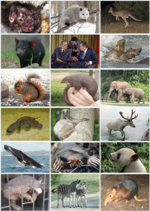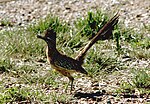Insect thermoregulation is the process whereby insects maintain body temperatures within certain boundaries. Insects have traditionally been considered... 16 KB (2,114 words) - 17:30, 15 February 2024 |
As in other mammals, thermoregulation in humans is an important aspect of homeostasis. In thermoregulation, body heat is generated mostly in the deep... 14 KB (1,840 words) - 19:58, 9 February 2024 |
 | Pinniped (redirect from Thermoregulation in pinnipeds) Pinnipeds (pronounced /ˈpɪnɪˌpɛdz/), commonly known as seals, are a widely distributed and diverse clade of carnivorous, fin-footed, semiaquatic, mostly... 106 KB (12,614 words) - 16:57, 24 March 2024 |
 | Rabbit (redirect from Thermoregulation in rabbits) hares.[page needed] Rabbits' ears are an important structure to aid thermoregulation as well as in detecting predators due to the way the outer, middle... 78 KB (8,406 words) - 05:06, 26 April 2024 |
 | Bat (redirect from Thermoregulation in bats) water loss. Water helps maintain their ionic balance in their blood, thermoregulation system, and removal of wastes and toxins from the body via urine. They... 168 KB (18,182 words) - 04:34, 27 April 2024 |
 | Homeothermy (category Thermoregulation) Homeothermy, homothermy or homoiothermy is thermoregulation that maintains a stable internal body temperature regardless of external influence. This internal... 9 KB (1,040 words) - 01:27, 22 April 2024 |
 | Newt (section Thermoregulation) cutaneous water permeability, but promotes increased cutaneous blood flow. Thermoregulation, in combination with seasonal acclimation, describes the major mechanisms... 36 KB (3,836 words) - 21:18, 17 March 2024 |
 | Mesotherm (category Thermoregulation) coined to advocate for an intermediate status of non-avian dinosaur thermoregulation, between endotherms and ectotherms. A more technical definition was... 7 KB (756 words) - 02:31, 22 September 2023 |
 | Turtle (section Thermoregulation) Turtles, or testudines, are reptiles of the order Testudines, characterized by a special shell developed mainly from their ribs. Modern turtles are divided... 126 KB (13,068 words) - 02:12, 26 April 2024 |
 | Neural spine sail (section Thermoregulation) for the function of the sail. The structure may have been used for thermoregulation. The base of the spines have a channel which may have contained a blood... 7 KB (803 words) - 13:46, 7 November 2023 |
 | Mammal (section Thermoregulation) in the spinal cord. The primary function of the fur of mammals is thermoregulation. Others include protection, sensory purposes, waterproofing, and camouflage... 212 KB (22,683 words) - 14:21, 20 April 2024 |
 | Tyrannosaurus (section Thermoregulation) homeothermy, it does not necessarily mean that it was endothermic. Such thermoregulation may also be explained by gigantothermy, as in some living sea turtles... 213 KB (23,450 words) - 04:11, 24 April 2024 |
 | Viviparous lizard (section Thermoregulation) Zootoca vivipara lives in very cold climates, yet participates in normal thermoregulation instead of thermoconformity. They have the largest range of all terrestrial... 30 KB (3,369 words) - 01:04, 14 February 2024 |
 | Dryocampa rubicunda (section Thermoregulation) Dryocampa rubicunda, the rosy maple moth, is a small North American moth in the family Saturniidae, also known as the great silk moths. It was first described... 16 KB (1,809 words) - 01:54, 3 March 2024 |
 | Shark (section Thermoregulation) Sharks are a group of elasmobranch fish characterized by a cartilaginous skeleton, five to seven gill slits on the sides of the head, and pectoral fins... 141 KB (14,114 words) - 01:10, 22 March 2024 |
 | Nephila (section Thermoregulation) Nephila is a genus of araneomorph spiders noted for the impressive webs they weave. Nephila consists of numerous species found in warmer regions around... 32 KB (3,989 words) - 22:22, 27 April 2024 |
 | Roadrunner (section Thermoregulation) The roadrunners (genus Geococcyx), also known as chaparral birds or chaparral cocks, are two species of fast-running ground cuckoos with long tails and... 18 KB (1,712 words) - 16:36, 30 March 2024 |
 | Black squirrel (section Thermoregulation) that its frequency is the result of crypsis, and/or the result of thermoregulation. It has been theorized that non-melanistic gray squirrels have a concealment... 40 KB (4,495 words) - 15:25, 17 April 2024 |
 | The tammar wallaby (Notamacropus eugenii), also known as the dama wallaby or darma wallaby, is a small macropod native to South and Western Australia.... 52 KB (5,826 words) - 01:47, 16 March 2024 |
up panting in Wiktionary, the free dictionary. Panting is a form of thermoregulation. Panting may also refer to: James Harwood Panting (1854–1924), British... 583 bytes (98 words) - 12:58, 25 July 2022 |
 | African clawless otter (section Thermoregulation) The African clawless otter (Aonyx capensis), also known as the Cape clawless otter or groot otter, is the second-largest freshwater otter species. It inhabits... 10 KB (1,273 words) - 23:50, 12 December 2023 |
Parabrachial nuclei (section Thermoregulation) send that information to neurons in the preoptic area involved in thermoregulation. A study in 2017, has shown this information to be relayed through... 15 KB (1,831 words) - 17:02, 15 November 2023 |
 | Skin temperature (section Thermoregulation) Skin acts as both a medium and means for delivering mechanisms of thermoregulation, including insulation, sweating and control of blood flow. Skin tissue... 28 KB (3,243 words) - 05:27, 27 August 2023 |
 | Common ostrich (section Thermoregulation) adaptations for thermoregulation, such as altering their feathers. Common ostriches display a feather fluffing behavior that aids them in thermoregulation by regulating... 122 KB (13,267 words) - 14:54, 18 April 2024 |





